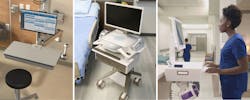Dueling dangers require standard, universal process, product solutions
Against the backdrop of staff shortages and employee fatigue fomented in part by the global pandemic during the last two years, healthcare organizations recognize the need to protect and value the professionals that deliver patient care and manage operations from dual dangers.
This support involves sourcing, evaluating and purchasing products designed to reduce fatigue, injuries, pain, pressure and stress. From suffering carpal tunnel syndrome, back and shoulder pain, foot and knee pain, falls, sharps injuries and workplace violence, those on the front lines and back offices of healthcare organizations face a great deal of tension during any given day. While personal protective equipment (PPE) provides safeguards from dangerous exposure to blood and other bodily fluids and tissues that can spread infectious pathogens on the one hand, ergonomic, injury-prevention and safety-related products cover what they face on the other hand.
The market offers a plethora of products designed to ease emotional, mental and physical burdens that include adjustable furniture, flooring, mats, injury-prevention and safety-designed devices and more.
Leaping over hurdles
Healthcare organizations grapple with several impediments that can slow or even stymie investment in ergonomic, injury-prevention and safety-related products.
One involves priority.
“The good news is that over the last few years, there has been growing attention toward the comfort and well-being of healthcare staff,” Hazelwood said. “The healthcare community continues to make great strides in understanding and addressing safety and ergonomics-related issues.
“Many of our healthcare customers tell us that ergonomics and safety at the point of care are priorities,” he continued. “However, executing on that priority can often be a challenging task as a host of other day-to-day operational challenges and priorities understandably demand attention and resources. Sometimes customers are not fully aware of all the safety and ergonomic issues in their facilities. For example, the demographics of healthcare workers are associated with specific issues that may not be recognized.”
Hazelwood cites data from the Bureau of Labor Statistics that reports 76% of healthcare workers are female and further notes that the average height of females in the U.S. is just under 5 feet 4 inches.
“The typical equipment found in clinical environments often is not designed for average-height healthcare workers,” he indicated in a bit of deductive reasoning. “For example, in many instances healthcare workers resort to using stools or other devices to see or reach supplies on upper shelves of cabinetry. Not only is this a safety issue, but the overstretching can cause aches and pains.”
Another involves economics.
“Budget is a common one,” Grenwis acknowledged. “There can be financial pressures to purchase based on price rather than selecting the most suitable option for the work to be done. Similarly, there can be a tendency to stick with familiar products or manufacturers rather than choosing something different, even if it may be an improvement.
“Additionally, some customers may not clearly understand the differentiation between products and manufacturers, which can create confusion, especially among heterogenous purchasing groups with different experiences, pain points and needs,” she continued. “But ultimately, healthcare organizations are oriented toward providing patients with excellent care and equipping caregivers with the support and resources they need to provide that care. When that focus remains top of mind, finding solutions that meet the stakeholder group’s needs becomes easier.”
“In the face of high hospitalization rates and staff shortages, healthcare worker safety is paramount,” Duesman told Healthcare Purchasing News. “Hospitals must look to the safest technology, regardless of contracts, to effectively protect workers. Innovative safety technology, such as retractable syringes and needles, have proven to significantly reduce needlestick injuries.”
Mary Kelly Jagim, RN, CEN, FAEN, Principal Consultant, CenTrak, recognizes that staff support and buy-in can be significant hurdles when considering new technology or equipment, particularly when it’s designed to protect against workplace violence. The purchasing process and workflow for such automated technology needs to be outlined and streamlined.
“When it comes to a new internal equipment launch or campaign, the key components for success are early transparency, proactivity and staff education of the technology’s use cases,” Jagim said. “Successfully deploying new solutions, such as Real-Time Location Systems (RTLS), requires incorporating the proper expertise from the healthcare facility, vendor and key stakeholders in nursing, marketing, patient experience, security, and administration. Bringing together leadership with varying viewpoints and expertise allows healthcare facilities to better develop proactive communication strategies and comprehensive educational programs.
“By providing transparency and early education on the technology’s purpose and how it can benefit workflow, patient care and safety without concern for negative consequences, leadership and healthcare professionals are more likely to accept and adopt the technology,” she continued. “This is especially important when it comes to new safety equipment. Without widespread staff adoption, it won’t be as effective. As an example, it’s beneficial to incorporate or enhance the system-wide culture of safety. This ensures staff know they have the facility’s support as workplace violence continues to increase. Strong support can lead to greater peace of mind, retention, and help with hiring purposes.”
Jagim recognizes the economic and resource hurdles that have surfaced during the last few years, but she encourages healthcare organizations to establish and carry out an effective plan.
“The first step to remedying these concerns is to properly identify and prioritize the major pain points impacting your healthcare facility and implement a solution that solves the challenge,” she advised. “When incorporating the new technology, make sure your team selects a solution with infrastructure that can scale and support multiple use cases with minimal rework or downtime. In addition to infrastructure, make sure to select a solution partner that offers go-live support. These key decisions ensure facilities can quickly implement a cost-effective, secure solution with room to grow.”
Much of the attention and diligence toward patient and staff safety during the last few decades has concentrated on respiratory, blood and body fluid exposure from influenza, Ebola, SARS, SARS Cov-2 and RSV, according to Barbara Strain, MA, CVAHP, Principal, Barbara Strain Consulting LLC.
“The biggest safety obstacle has come through lack of knowledge in how to protect staff from novel pathogens,” Strain observed. “It may take weeks or months to learn the true route of transmission and what type of protection already exists or will need to be developed, approved, manufactured, purchased and put into use. In the late 1970s early 1980s the first cases of what was later identified as AIDS caused by HIV started to emerge and serve as the genesis of OSHA’s Blood-borne Pathogen Standard that was first issued in 1991. The staff protection industry grew exponentially to what is found today; Gloves, eye protection, masks, gowns and sharps safety to list a few.”
Ergonomics concerns have emerged due in part to the rise in obesity in the U.S., Strain continued, citing a 2020 briefing by The Advisory Board Co. (https://www.advisory.com/daily-briefing/2020/12/17/obesity) as affecting patients and caregivers alike.
“The development of patient comfort products/equipment to adapt to the comfort and ability to treat patients has caused safety and ergonomic issues for bedside staff,” she noted. “End-user equipment and products with a staff ergonomics focus involve patient movement – positioning in bed, transfer out-of-bed to chair or stretcher, and in OR/Procedures/Treatment situations, especially of long duration.”
Strain points to patient and product transport, such as staff pushing wheelchairs and stretchers, moving and using radiology or other portable equipment, and being able to access permanently placed small equipment or dispensing products used in patient rooms, such as suction, paper towels, used sharps or regulated medical waste dispensers that need to be conveniently reached on either side of patient by only one staff member.
She also targets storage areas as another area of concern in terms of easy and safe access with assistance when needed. Strain quips that this shouldn’t be a “10 pounds of sugar in a 5-pound bag” syndrome, an adage that references effective and efficient capacity, convenient access to equipment and products being in the right place at the right time.
Pushing ‘ESP’ to the forefront
What will motivate healthcare organizations to propel ergonomics, safety-designed and protective-related products (ESP) to a higher priority of awareness and action?
For Ergotron’s Grenwis, it’s involvement, research and time.
“In healthcare, safety really matters,” she emphasizes. “According to current data from the U.S. Bureau of Labor Statistics, workplace illness and injury rates are higher in healthcare than in any other industry. Healthcare safety encompasses much more than preventing well-known dangers like accidental needle sticks — there are a vast number of risks that caregivers are exposed to that can result in illness or injury.
“Safety and ergonomics are interdependent and work together to enhance the caregiver experience,” Grenwis continued, promoting an eBook that Ergotron offers. “Research has demonstrated the importance of ergonomics in healthcare settings and how ergonomic solutions support caregiver health and well-being. This information is useful to share when working with a team of stakeholders making purchasing decisions.”
Healthcare organizations naturally should consult with their staff members for input, too, she urged.
“Relevant research data paired with feedback from caregivers and staff on what’s working well and areas for improvement in the hospital, clinic or facility can be a valuable starting point to engage with healthcare solution providers,” she said. “Demos or learning sessions with manufacturers or resellers allow members of the purchasing and clinical teams to come together to explore various products or workflow improvements that best address the pain points and meet stakeholder needs.”
Midmark’s Hazelwood stresses the incorporation of evidence-based clinical design.
“One important way to elevate safety and ergonomics features in the purchasing of products is for healthcare organizations and workers to make clinical design a factor in the consideration of new equipment and furniture,” he noted. “Understand the role clinical design can play in helping improve safety and ergonomics and make it a priority to purchase equipment that is designed specifically for the healthcare environment and staff. Caregivers should not have to adapt to the equipment and furniture; rather the equipment and furniture should and can be adapted to them.”
Hazelwood further recommends talking to equipment and furniture suppliers about safety and ergonomic issues and ask about features of their products that might be able to address these issues.
RTI’s Duesman refers to regulatory agencies such as OSHA for guidance when appropriate and necessary, particularly in the area of injury.
CenTrak’s Jagim acknowledges that disruption from the global COVID-19 pandemic “amplified staff burnout and stressed the labor market, driving the turnover rate for registered nurses in 2021 to increase by 8% and greatly reduce the retention of knowledgeable staff.” That’s why she encourages healthcare organizations to invest in their staff.
“Lessening the stress placed on healthcare professionals is a critical aspect of combating burnout and promoting staff retention, and healthcare leaders will find that investing in their staff during the coming year makes sense for satisfaction, safety and the facility’s bottom line,” she noted. “According to The Joint Commission, reducing workplace burnout and violence can improve patient care and decrease distress, job dissatisfaction, turnover, and costs. The cost of injuries from workplace violence now lands around $94,156 per incident.” She also cites that the cost to replace a nurse who leaves has climbed to $60,000.
Jagim further indicates that disruption from the pandemic heightened pressure and stress among everyone, which has increasingly vented through workplace violence.
“Violence against healthcare staff is not new,” she insisted. “Since the start of the pandemic though, violence has surged. Some hospitals have experienced more than a 50% increase in dangerous incidents. An IoT-enabled RTLS safety solution provides a reliable, secure and real-time duress alerting system that prevents threats from escalating into violent situations by arming healthcare professionals with the ability to discreetly send panic alerts to the security team and their colleagues from an easily accessible button on their wearable badge. Advanced duress systems can easily integrate with a variety of existing systems, including automated nurse call.”
Strain advises planning ahead and communicating needs before they become an issue.
“Assure that all current policies and regulations are up-to-date, staff are trained, and products and equipment are available,” she said. “Most importantly is providing an environment where staff are part of the decision-making process when it comes to their own safety, comfortable to report issues, expected to immediately report to Employee Health or other internal/external source of care per your organizations policy (e.g., ED after regular hours or weekends) and aware of workman’s comp, disability or HR policies concerning their health and safety.”
Strain advises healthcare organizations to maintain an active organization-wide staff safety committee that reviews injury rates by type of staff injured, what were they doing when they were injured, where the injury occurred-hand, arm, eye, etc., and physical location as well as preventive recommendations.
“Survey staff at least once a year about the culture of safety in your organization,” she said. “Take actions by adopting work practice controls, review current products or physical situations identified as concerns or found to be problematic through data collection, and take immediate action when potential life-threatening incidents occur. These and other actions can instill trust that your organization has created a safe work environment.” hpn
Shopping for ergonomic, safety-designed, protection-related products
What are some key elements to consider when sourcing, evaluating and purchasing products designed with ergonomics, injury prevention and safety in mind? Experts share their strategies and tactics.
“A reputable manufacturer or reseller will have representatives to help set the healthcare team up for success. Leverage their expertise and knowledge of workflows to identify solutions that best meet the needs of healthcare workers and other stakeholders, like the IT team.
When evaluating ergonomic solutions, ensure that adjustment is simple, such as lifting and lowering a workstation’s worksurface to accommodate sitting or standing. Make sure computer monitors are adjustable for comfortable viewing. Mobile workstations should be easy to move in and around patient rooms and hallways. Access to supplies, technology and other tools should be intuitive.”
Jessica Grenwis, Director of Customer Marketing, Healthcare, Ergotron
“Key elements to consider when looking at equipment and furniture for the exam room include:
- • “Exam chairs that are fully adjustable to prevent caregivers from having to overreach, twist or bend their back or torso too much during exams. The chairs should also be able to lower to a height that allows patients to transfer onto it without being lifted by a caregiver. Additionally, exam chairs should have built-in, retractable roller bases that allow caregivers to safely move the exam chair for cleaning and disinfecting.
- • “Mobile workstations that have easy vertical adjustment, tilt and rotation functionality to promote proper posture with neck, shoulder, arm and wrist alignment, allowing proper working positions so as not to cause unnecessary strain. Workstations should also feature fully adjustable arms to allow monitors to be easily positioned for both sitting and standing postures.
- • “Cabinetry that is designed to enable caregivers to easily reach frequently accessed supplies without unnecessary bending or stretching or constant overreaching. This includes a lower upper height and more shallow cabinet depth, as well as gravity-fed, angled flow shelving that improves visibility and access to supplies.
- • “Clinician stools that are easily adjustable and maneuverable to allow caregivers to find the most comfortable working height and maintain neutral postures, while also providing a backrest to promote better posture and support the back.”
Brian Hazelwood, Marketing Manager, Midmark
“Key elements include efficacy, workflow, and sustainability. With regard to needlestick prevention, automated retraction devices that allow for pre-removal activation have demonstrated the highest rate of efficacy, without impairing workflow. In addition, devices with integrated safety mechanisms, such as retractable syringes, reduce disposal volumes, which not only saves money, but also promotes sustainability through a reduction of a facility’s ecological footprint.”
Kathryn Duesman, RN, Vice President of Clinical Affairs, Retractable Technologies, Inc.
“Many organizations have a desire for a single application when they first explore [Real-Time Location Systems], such as staff duress or infant protection. Leaders often have a desire to implement additional use cases though as the team experiences the technology and associated safety benefits. Selecting an RTLS partner with a comprehensive suite of solutions makes it easier to scale to other use cases and departments in the future. The most advanced RTLS deploys clinical-grade visibility, which allows healthcare teams to securely capture the precise movement and exact locations of staff, patients, infants, visitors, etc. Accurate location data is crucial in speeding up emergency response times and efficiently locating staff under duress, viewing any unauthorized location changes to protect newborns, and providing wander management. Additional RTLS offerings include capabilities such as nurse call automation, automated hand hygiene monitoring, asset management and temperature monitoring using easy-to-implement, cost-effective technology that benefits the patient, staff and facility.
“When considering a new tech solution, take the time to assess the current pain points and the anticipated roadmap for the next few years. In addition to a comprehensive suite of solutions, healthcare facilities should look to truly partner with a strategic vendor who will explore the organization’s objectives and pain points and deliver a three-to-five-year implementation plan with associated [return-on-investment] projections and necessary operational resourcing. Through practical guidance, healthcare facilities can maximize new technologies and drive meaningful change throughout their enterprise. After a comprehensive and collaborative review of current processes, an advanced solutions partner will offer recommendations on ways to increase efficiency and reduce operating costs using a thoughtful application of the solution.”
Mary Kelly Jagim, MS, RN, CEN, FAEN, Principal Consultant, CenTrak
“When new products are reviewed by value analysis or referred to value analysis to find more effective safety or ergonomic styles the key elements they look for are based on internal and external data driven evidence along with human factor engineering applications. Examples of internal data are related to the who, what, where, how analytics and root cause analysis/A3 assessments. External data sets come from reports such as FDA’s MAUDE, MedSun-Medical Product Safety Network, recalls, alerts and warnings. Reference articles in the literature focused on healthcare workplace injuries and resolution strategies are another external resource to call upon.
“If the reason for injury clearly points to a product failure or product use complexity issue, then looking for products whose manufacturer conducted human factors engineering in their final review before launch is serious consideration. Healthcare organizations will also want to review if they included or will include a human factor engineering approach during their evaluation process prior to implementation of products into their environments.
“For those not familiar with human factor engineering may want to review to the FDA guidance document, “Applying Human Factors and Usability Engineering to Medical Devices,” (https://www.fda.gov/regulatory-information/search-fda-guidance-documents/applying-human-factors-and-usability-engineering-medical-devices) to ‘assist industry in following appropriate human factors and usability engineering processes to maximize the likelihood that new medical devices will be safe and effective for the intended users, uses and use environments.’
“A simple risk assessment approach to reviewing and decision-making for products may include questions such as:
“An extra layer of difficulty in shopping and sourcing safety and ergonomically designed products is finding specific key words in a site search or the manufacturer’s website or when contacting your sales representative or inside customer service this may not be topic they have been trained to answer.
“Time for a ‘easy button’ approach to facilitate doing the right thing every time and take variation and waste out of the healthcare system.”
Barbara Strain, MA, CVAHP, Principal, Barbara Strain Consulting LLC
About the Author
Rick Dana Barlow
Senior Editor
Rick Dana Barlow is Senior Editor for Healthcare Purchasing News, an Endeavor Business Media publication. He can be reached at [email protected].







